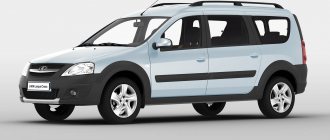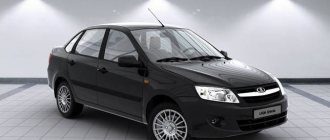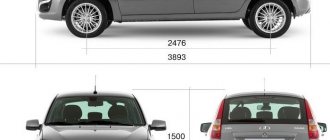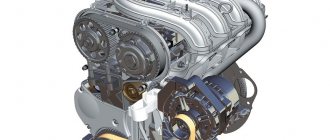If the image doesn’t bother you, you like the ground clearance, like a jeep, and in addition, you’ll admire the large capacity in the form of a 5/7-seater interior and a huge trunk, and “not expensive” - that’s all, we’ve arrived. Yes, not on anything, but on a raised Lada Largus with a talking Cross prefix and, of course, DNA from Renault Logan. This model, first presented to Russians in 2015, does not have many competitors. Of the serious ones, we can only remember the Lada Kalina Cross (in-brand cannibalism, as they say), and of the not very serious ones - the Renault Sandero Stepway, which seems small compared to the Lada station wagons, and the “Chinese” like the Lifan X50/X60 or the Geely MK Cross, whose reputation , alas, cannot boast of impeccability. Read all the details about the cross-version, which was begging to be released after the standard Largus with its modest ground clearance, in our review!
Design
Design
While working on the chassis settings, Lada engineers were equally concerned about handling and the quality of driving comfort. The stretched budget B0 chassis from Renault Logan (wheelbase is as much as 2,905 m) provides the Largus Cross with excellent directional stability. The station wagon clearly moves along a given trajectory on a high-speed straight line and on turns, and it is extremely difficult to knock it off the intended path. The smooth ride of the cross-version is slightly worse than that of the regular Largus: the suspension transmits “small things” into the cabin, but it perfectly absorbs large irregularities. For broken roads, this is undoubtedly a worthy option.
Adaptation to Russian conditions
The Largus Cross does not have an all-wheel drive transmission or simulated cross-wheel locking with the ESC system, but it can be driven on light and dry off-road conditions, since the model has good cross-country ability. An additional insurance when driving on deep ruts or a snowy yard is a plastic body kit. For trips to the country or fishing, you can’t think of a better option for similar money. In order not to freeze in winter, the car is equipped with heated front seats and side mirrors. And to create optimal conditions in the summer, there is air conditioning, and in absolutely all trim levels. Unfortunately, heated steering wheel and windshield are not allowed.
Comfort
Safety
The standard equipment of Largus Cross, unlike Largus, includes not one, but two airbags - for the driver and front passenger. You won’t have to pay extra for other pillows - they are simply not provided here. The “base” also has Isofix mounts for child seats, anti-lock braking system (ABS), brake force distribution (EBD) and engine crankcase protection made of 2 mm thick steel. Available options include: an emergency button to call emergency services in case of an Era-Glonass accident and rear parking sensors. By default, the car is equipped with reinforced front suspension arms and the largest possible brakes. The body has special anti-corrosion and anti-gravel protection.
Specifications
| Characteristic | 1.6MT |
| Engine's type: | Petrol |
| Engine capacity: | 1598 |
| Power: | 106 hp |
| Acceleration to 100 km/h: | 13.1 s |
| Maximum speed: | 165 km/h |
| Consumption in the urban cycle: | 11.5/100km |
| Extra-urban consumption: | 9.5/100km |
| Combined cycle consumption: | 9.0/100km |
| Fuel tank capacity: | 50 l |
| Length: | 4470 mm |
| Width: | 1756 mm |
| Height: | 1682 mm |
| Wheelbase: | 2905 mm |
| Clearance: | 170 mm |
| Weight: | 1270 kg |
| Trunk volume: | 560 l |
| Transmission: | Mechanical |
| Drive unit: | Front |
| Front suspension: | Independent – McPherson |
| Rear suspension: | Semi-independent – torsion beam |
| Front brakes: | Disk |
| Rear brakes: | Drums |
| Production: | Tolyatti |
Dimensions Lada Largus cross 5 seats
- length - 4.470 m;
- width - 1.756 m;
- height - 1.682 m;
- wheelbase - 2.9 m;
- ground clearance - 170 mm;
- trunk volume - 560 l.
Lada Largus Cross photo
Read further:
Amazing hatchback Lada X-Ray Cross: price and specifications in Russia
XRAY Cross: all-wheel drive car from Lada
AvtoVAZ is preparing a new Lada Van based on Largus
The interior of the Lada Vesta is not impressive
Five-year plan from Lada
Other reviews
Against the background of the constant appearance of new cars on the world market, the Lada Vesta of the 2015 model year is not such a new product. However, it can still be considered the discovery of the Russian car market thanks to its very modern appearance and well-thought-out technical “stuffing”. The sedan's exterior was designed by ex-Mercedes-Benz and Volvo designer Steve Mattin, and was among the first people lucky enough to sit in it.
The raised cross-country hatchback Lada Xray, which AvtoVAZ dubbed a crossover for advertising purposes, is called by many the highest quality model of the domestic manufacturer, and there is indeed reason for this. Firstly, there is an abundance of high quality imported parts, and secondly, this car has decent ground clearance and a proprietary 1.8-liter engine.
Cars nowadays don't work on anything. There are even hydrogen ones that literally “live” on fuel cells. Water is, of course, good and incredibly environmentally friendly, but it is still painfully unpopular and expensive to implement. Is it compressed natural gas or, as it is also called, methane in a cylinder, like the new version of Lada Vesta CNG (Compressed Natural Gas)! A gas sedan is cheaper.
5- and 7-seater Lada Largus station wagons appeared on the Russian market in 2012, becoming a kind of continuation of the cheapest Renault Logan model, only under the auspices of a domestic manufacturer. As you might guess, the Logan-like Largus turned out to be the first Lada car built on the basis of the budget B0 platform, on the basis of which a number of Lada, Renault and Nissan models were designed.
The domestic auto industry never ceases to amaze. For example: when the Russian press first said that AvtoVAZ was preparing a “sports” version of the second Lada Kalina in a hatchback body, it was more difficult to get a new product for a test drive than another Bentley or Mercedes. Amazing, right? For VAZ people there is nothing special about this: not many significant new products are released after all.
What is a 3- or 5-door Lada 4×4 with the Urban prefix? Some kind of supernova Niva? In relation to an off-road passenger car from the glorious city of Togliatti, these words smack of piercing irony. New, of course - it’s been around for almost 40 years, of which 10 years the model has not been called Niva. But somehow I can’t seem to forget about my “maiden name”... So, what does “urban” promise?
It will not be a revelation to anyone that AvtoVAZ literally slept through the SUV boom. And one day they decided to somehow make up for this matter and in the summer of 2014 they presented to the general public the all-terrain all-terrain station wagon Lada Kalina Cross, built on the basis of Kalina 2. In order to become a “Cross”, the model had to survive not only external, but also internal, technical.
Dimensions
Chassis
Fuel
Engine
Ground clearance is the distance from the lowest point in the center of the car body to the ground. However, the manufacturer of Lada Largus Cross measures the ground clearance as it suits him. This means that the distance from the shock absorbers, engine oil pan or muffler to the asphalt may be less than the stated ground clearance.
Advantages and disadvantages
Pros of the car
- The car is quite spacious and roomy;
- Spacious trunk even when the second row is full (in the 5-seater version);
- High ground clearance;
- Inexpensive price;
- Energy-intensive suspension;
- Good equipment;
- Quite cheap service;
- For such a price, pretty good dynamics;
- Low fuel consumption;
- There is an option with a third row of seats;
- The appearance is quite aesthetic and attractive;
- Good layout of the tailgate doors;
- There is crankcase protection;
- Reliability of the design;
- Managed without any difficulties.
Cons of the car
- The control unit for the stove and air conditioner is not located in the best place;
- Inconvenient access to the spare tire;
- Poor interior ergonomics;
- Lack of armrest and other places for various small things;
- There is no profile of the front seats;
- Lack of protection for the gas tank cap;
- Limited choice of power units;
- Large dimensions;
- Build quality and materials used;
- Plastic is used that emits an unpleasant odor;
- The engine does not always have enough power;
- There is no all-wheel drive system;
- Poor quality multimedia system.
Unfasten the partition or part of it
The partition separating the body and the cabin consists of two halves. They can be removed separately. Both parts are screwed to the body with screws designed for a 13mm key size. Of course, you need a socket wrench.
Screws 1 were hidden under the casing
The four screws on the left and right are located on the cab side. And to unscrew them, remove the casing.
All actions with cladding
The left part of the septum is removed after the right. To remove only the left half, first remove both, and then mount the right sash back. Based on this, immediately decide where you will remove the trim - only on the right or on both sides.
So, let's start dismantling the trim: you need to remove the seat belt (key “17”), and then unscrew one self-tapping screw. A Torx T20 wrench is suitable for the self-tapping screw.
Two parts “1” prevent the removal of casing “2”
It is necessary to unscrew all the parts numbered 1. And the casing will have to be removed, overcoming the resistance of the clamps.
Largus Van interior
The interior of the cargo-passenger Largus is designed to seat two people (driver and one passenger) and is equipped with seats with mechanical adjustment in four directions. What else can be noted in the car interior:
the steering column is adjustable, but only in height;
the chairs are generally comfortable, but with insufficiently rigid backrests;
the ceiling in the cabin is high, there is more than enough headroom;
the instrument cluster has speedometer and tachometer dials on the sides, a small monochrome display occupies the middle position;
almost all control elements (keys for power windows, central locking, emergency lights, handles for air conditioning and heating systems) are located centrally on the dashboard or on the center console, there is also a 12-volt socket;
steering wheel – three-spoke, without keys;
there is no interior mirror;
The interior door panels are made of hard plastic.
The seat heating buttons are installed on the sides of the seats themselves, on the door side, but in the poorest configuration they will not be there, as well as the ESP buttons. The air ducts on the dashboard are round in shape; in appearance they resemble deflectors from a Gazelle.
Interior
As soon as you get into the salon, you immediately see that nothing major has been changed in the interior. The driver's seat is still comfortable and can accommodate drivers of all sizes and shapes. In some configurations, the chair may have adjustable lumbar support and a steering column with settings in the vertical plane. To set the seat position, you can use simple adjustments.
The high seating position improved visibility. So, when you sit in the front seat, the view is almost perfect. Even the very wide A-pillars do not interfere with your ability to look at the road situation.
The front panel, as well as the electronic equipment, remains the same. Among the features is the horn. It is set in French, and for Russians this is a little unusual. Its button is now at the end of the right steering column toggle switch.
Asceticism
The only obvious drawback of the Lada-Largus is its deliberate asceticism. The interior of the car has not changed at all since the creation of the first generation Renault Logan. This model contains only the bare minimum. But many car enthusiasts today want to see some additional frills in their cars, such as heated seats and mirrors, modern multimedia, and electronic assistants. The impressive dimensions of the Lada-Largus van, heated front seats, a single-din radio, an ABS system and rear parking sensors are all that are included as standard. The car is equipped with only two airbags and manual air conditioning.
Many cars are created with the aim of setting speed records and most of them captivate with their stylish and original design. The Lada-Largus van, with a body size that allows it to transport large items, was invented specifically for work and family. The car will be able to drive where sports cars with low clearance cannot move. At the same time, drivers will look at the Lada-Largus with real love, because only a working car is considered truly beautiful.
How to increase ground clearance on your own?
For contrast, we note that in the cohort of owners of the station wagon we are considering, there are quite a lot of subjects who, pursuing the goal of tuning, lower the ground clearance. This significantly reduces the practicality of the car, turning it into an exhibition piece at various tuning events.
The same owners of Lada Largus, who have a spirit of innovation and a desire to use the full potential of their own car, on the contrary, strive to increase ground clearance. In everyday use, this idea more than justifies itself if the driver, by the will of fate, has to act as a carrier.
Increasing the lumen is achievable through the use of several methods, used both individually and together.
- installation of wheels with a slightly larger radius;
- installation of special inserts between the body and shock-absorbing struts;
- the use of reinforced springs together with longer struts.
Now let's move on to describing each of the methods separately.
Design Features
The main differences between the appearance of the Largus Cross body and the station wagon are:
- more aggressive and modern design;
- the presence of plastic linings on bumpers, sills and wheel arches;
- 16-inch light alloy wheels.
The interior of the new model has become more spacious and now looks much brighter. This applies primarily to the original orange leather inserts in the shoulder area on the back of the front seats. Some elements of the door trim and trim on the center console are also painted. And on the thresholds of the car you can see the series logo - the inscription “Largus Cross”, made on a plastic insert.
Engine tuning
Many motorists want to make their engines better and more powerful. This is why the tuning and modification procedure is carried out. For engines such as the Lada Largus, there are two options for modification - mechanical and software tuning. But, most vehicle owners prefer to make a second modification.
Soldering the chip into the ECU
In order for everything to work out and not have to often stand in line to see an electrician-programmer, the ideal option is to install a chip in the engine control unit. After this, the software is installed, and subsequently the chip regulates the operation of all necessary systems.
How is the actual process of introducing a chip into the “brains” of a vehicle carried out? This procedure is quite difficult and requires advanced knowledge in radio electronics, as well as automotive electrical engineering. So, this process is best left to specialists.
The chip itself can be mounted (soldered) directly into the electronic engine control unit or at an intermediate stage, depending on the purpose of the equipment.
Recently, controllers and various chips that motorists install into their cars themselves have become popular. As practice shows, this does not always have a positive effect on the performance of automotive systems. Experts and auto electricians recommend that before installing anything in a vehicle, consult with professionals and weigh all the pros and cons.
Brain firmware
The second option is chipping the standard engine control unit. Motorists and craftsmen divide this type of tuning into three parts:
- Firmware to reduce fuel consumption.
- Firmware to increase power.
- Balanced firmware.
As practice shows, most owners of Largus engines use the option with reduced consumption. It is worth understanding that by reducing the flow rate, the dynamic characteristics are also reduced. Thus, power units may respond late to changes in the position of the accelerator pedal, which in turn does not have a very good effect when overtaking.
It is worth noting that the chipping procedure must be trusted to professionals. Only they will tell you what type of tuning is most suitable for the engine and will take into account the wishes of the motorist.











